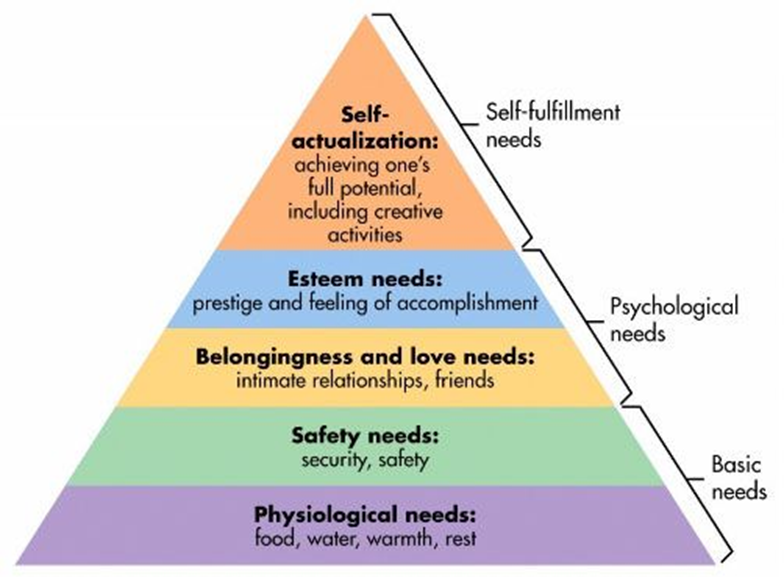
Abraham Harold Maslow (April 1, 1908 – June 8, 1970) was an American psychologist who was best known for creating Maslow’s hierarchy of needs, a theory of psychological health predicated on fulfilling innate human needs in priority, culminating in self-actualization.
In 1943 Maslow stated that people are motivated to achieve certain needs and that some needs take precedence over others. Our most basic need is for physical survival, and this will be the first thing that motivates our behavior. Once that level is fulfilled the next level up is what motivates us, and so on.
How are these concepts related to marketing and sales in B2B environment? In a couple of ways.
Conditions of Need
There are what I call the three conditions of need. These conditions apply to ANY purchase—anything from getting your oil changed over a lunch break (perhaps driven by an ad on the radio during morning drive time) to multimillion dollar purchases of equipment, technology or services. The three conditions are:
- Fear of loss in your current situation
- Perceived risk of deterioration in your current situation
- Opportunity to improve your current situation
The easiest condition to sell into is fear of loss. A good example of fear of loss is when compliance laws are enacted and your company is not compliant. The fear of loss could be fines, inability to operate your business until you are compliant or immediate competitive threats. At any given time, only a small percentage of companies are in a fear of loss condition. So, you can’t wait for that condition to occur to begin selling to the prospect.
The second easiest condition to sell into is perceived risk. Some people have a hard time understanding the difference between fear of loss and perceived risk. Think about it this way. Fear of loss means that something is happening that threatens your existence. Perceived risk occurs when everything is fine right now, but there are factors in motion that are going to change your situation and you better make plans to defend your position. A good example of this is that many “big box” retailers are in a fear of loss condition. Some won’t make it (or already haven’t made it). Arguably, as little as five years ago, the big box stores should have considered themselves in a perceived risk condition and started earlier on the path to more ecommerce. Many didn’t.
The hardest condition to sell into is opportunity to improve. I call this selling into the rainbow. There are no basic needs or psychological needs (needs on Maslow’s hierarchy) to be satisfied by buying an opportunity to improve. It takes an individual who has reached the highest level—self-actualization—to take the risk to invest in a product or solution that only promises an opportunity to improve your current situation. An example of this (and demonstrating the potential for payoff) is the degree to which Apple’s Steve Jobs agonized over iPhone packaging. The product was already great. Yet, Jobs made changes (such as a change in shade of the box) so that the packaging was perfect for their perfect product.
Benefits
There is an old expression that features tell, benefits sell. A great example of this is when the iPod first came out. Instead of leading with how many gigabytes of storage the device had, Apple led with “1,000 songs in your pocket.”
There are benefits that are reasons people buy things for their company that are driven by company goals; and there are benefits that are reasons why people buy things for their company that are driven by personal goals.
Reasons why people buy for their company that are driven by company goals:
- Save money
- Save time
- Improve a product or service
- Save lives
The four benefits above are what I call the ultimate benefits. Ultimate benefits resonate with your prospects’ or customers’ professional desires. However, when marketing or selling, you can’t simply lead with the ultimate benefit. Generally, there is a string of benefits that is paid off by the ultimate benefit. Example: the 2017 version of this SUV weighs less than last year’s model. Thus, you get more miles to the gallon. With more miles to the gallon you save money.
Finally, people also buy for their company because they are driven by personal goals:
- Compensation
- Security
- Recognition
- Self-actualization (want to do the right thing even if it does not impact them on the lower levels of Maslow’s hierarchy)
See how closely these personal goals tie to Maslow’s hierarchy of needs? Most buyers are focused on compensation, security and recognition. The paucity of self-actualized decision makers is what causes so many “no decision” outcomes. “No decision” happens when the buyer or buyers perceive there is more risk in buying something than in doing nothing.
Look at your forecast. What are the conditions of need driving the evaluations? What ultimate benefit or benefits does the buyer desire? How can you mitigate risk so that the buyers’ personal goals are met?
Unless I sold iPhones I would not want to depend on trying to sell into the opportunity to improve condition of need and selling to self-actualized individuals. But, that’s just me.



